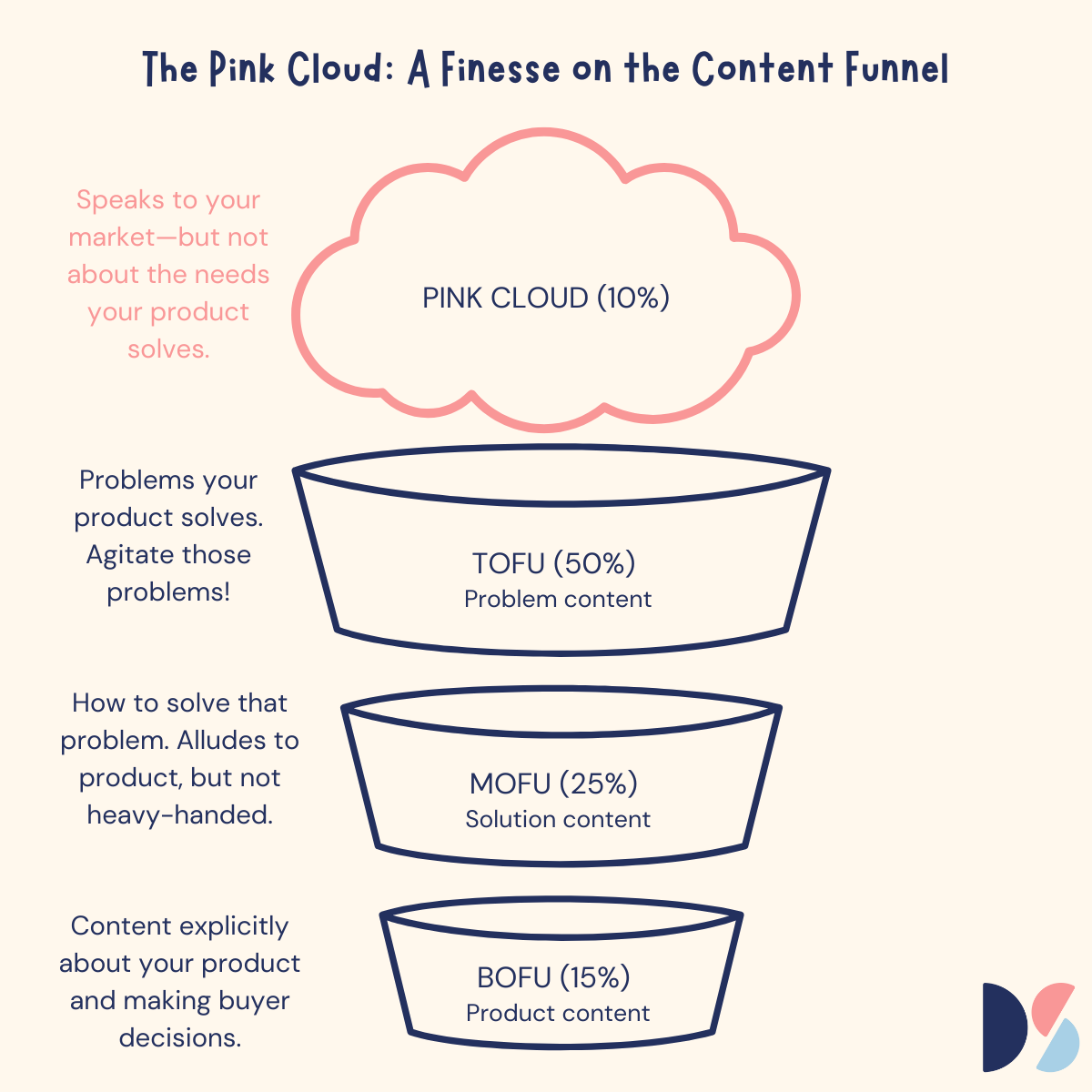The marketing funnel is total bullshit. But I still use it every day.
Lots of smart people say we should toss the entire concept of the funnel (e.g., Marc Binkley, Mark O’Brien, Anton Lipkanou, and many more). And honestly? I totally see their perspective. Yet I still find myself mapping content to funnel stages, discussing TOFU vs BOFU strategies with clients, and using the framework to organize marketing plans.
That's the tension at the heart of many frameworks, isn't it? We know they oversimplify the messy reality of how people live, work, make decisions, and more. But it’s this simplification that makes them useful—they help us navigate chaos and take control of a complex world. In marketing, the funnel is perhaps the most ubiquitous example.
Today I want to explore why the funnel is flawed, why I still find it valuable, and how tailoring your understanding of the funnel (like Digital Sisco does with our "Pink Cloud" concept) can bridge the gap between theory and real-world marketing.
Yep, the Traditional Funnel Is Kinda Bullshit
First, let’s all level-set on some of the flaws of the funnel that I wholeheartedly agree with:
1. People Don’t Move Through Buying Journeys in Neat, Linear Steps
Think about the last product you bought and what your path to purchase (both online and offline) looked like. Odds are, it didn’t follow the oversimplified funnel journey.Buyers might:
- Swim around in TOFU content for months, then suddenly nosedive straight to BOFU when a need becomes urgent
- Enter the funnel at different stages. Maybe your new boss tells you to go buy a specific software, and you skip straight to product comparisons without any "awareness" phase.
- Jump between stages unpredictably, and no amount of carefully crafted customer journey maps fully captures that chaos.
2. It Minimizes Emotional Decision-Making
The funnel implies people are rational beings who methodically progress through awareness, consideration, and decision. But that's not how humans work—especially in B2C, where emotional and impulsive decisions are common.
Consider how a single Instagram post showing your friend's vacation at a boutique hotel can trigger an immediate booking without any "consideration" phase. Or how many of us FOMO-try every new AI tool because we’re worried about being left behind rather than really making a considered buying decision.
Even in B2B, with all our process diagrams and procurement policies, the reality is messier than we'd like to admit. People are influenced by biases, relationships, and factors that don't fit neatly into funnel stages.
3. It Narrows (When Reality Sometimes Expands)
The funnel metaphor implies consistent narrowing at each stage, but in reality, some businesses see expansion at certain points. E.g.,- When content goes viral at the MOFU stage, you might actually widen your audience rather than narrow it
- Word of mouth doesn't respect funnel boundaries either – it creates new entry points and shortens journeys in ways the traditional model struggles to account for.
4. We Seldom Have the Data to Track the Funnel Story
Attribution is a mess. Last-click attribution tells half the story at best. Certain marketing channels get all the credit while others look like they’re driving mere vanity metrics. The connective tissue between the funnel stages is rarely, if ever, tracked and that story remains untold on most marketing teams.
This leads to a disproportionate focus on BOFU activities because they're closer to the conversion and easier to measure—not because they're actually more important. Everything that’s not BOFU often gets lumped into a vague TOFU catchall category.
How Digital Sisco Thinks About the Funnel
We’re a pragmatic team at Digital Sisco: We develop and present models to our clients that we think might serve them and help uplevel their approach to marketing (and their results).
We can definitely argue (and agree with) both sides of the funnel argument. But, for us, the useful, practical applications of the funnel trump the areas it falls short. You can simultaneously hold on to both!
One way we’ve made the funnel even more useful for both our work and clients is with our "Pink Cloud" concept. (If you want to dive deeper into how we think about the funnel and particularly our Pink Cloud concept, check out our detailed post on the topic).
High level, the Pink Cloud refers to content that speaks magnetically to your target audience but isn’t directly related to the problems your product or service solves. It sits above the traditional funnel, creating engagement and connection before explicit problem-solving begins. This new category helps us ensure that top-of-funnel doesn’t become a vague catch-all category.

We use these funnel definitions to organize our thinking and planning without being constrained by it. For example, we might map keywords and content to funnel stages in order to understand the historical work that has been done (and the implied strategy that was driving it) in order to understand gaps and potential challenges it has created for the teams we’re working with.
See, it’s not really about expectations of how people behave: We expect them to jump around, skip stages, and sometimes completely subvert our carefully constructed paths. It’s actually about understanding and improving the work clients do, and that we do for them.
For example, we often see:
- Clients who come to us frustrated by the efforts of past SEO agencies (we may diagnose that they were chasing Pink Cloud rather than lower funnel keywords)
- Clients who are envious of a Pink Cloud content strategy but expect to see it drive high conversion and are confused when all their cool storytelling only drives eyeballs, not revenue
- In-house content marketers who love to ideate Pink Cloud and TOFU but need our help thinking creatively about MOFU/BOFU content
- Content libraries that are all TOFU and BOFU but miss that MOFU headspace
Why We Still Use the Funnel Every Day
Despite its acknowledged flaws, I find the funnel incredibly useful:
1. It Reminds Marketers (and Stakeholders) That There’s Often a Path to Purchase
Marketing can often over-index on its investment in BOFU or conversion-attributed channels. But we all intuitively understand that not every marketing activity should be conversion-focused (no matter what our CFO or Chief Metrics Officer-style CMO says).
The funnel helps explain investments in awareness and consideration, recognizing that people need different types of information at different points in their journey. It reminds us that not everyone is ready to buy right now – and our marketing should address that reality.
2. It Challenges Teams to Contribute in Creative Ways (and De-Silo)
Marketing teams can get notoriously siloed. You may have a ‘fuzzy’ social media team and content team playing in Pink Cloud. Meanwhile, your performance marketers feel resentfully on the line to drive real metrics.
An SEO or content marketer may measure their contribution in rankings, clicks, and eyeballs and assume it’s somebody else’s job to convert them.
But every channel can likely contribute a little more to each funnel stage, while appreciating those connections. This helps teams connect dots to each other and to the ultimate result (revenue) rather than staying siloed and chasing individual metrics, real or vanity.
3. It Provides a Structure for Measurement
It’s so obvious but it does need to be said often: Different deliverables have different metrics of success.
Looking at your top-performing blog posts by page views alone may lead you to believe you should write more TOFU-style blog posts. But if you put on a different hat (like conversion), those TOFU posts may suddenly look junky compared to your ‘boring’ product marketing posts
The point is, that they each have different jobs and should be measured on the job they’re supposed to do, not against each other. The funnel helps set appropriate KPIs for different pages, pieces of content, and keywords—acknowledging that success can look different for different assets.
4. It’s a Shared Language
We work with many different clients, with many different skill sets and experience levels. And we’re usually working across marketing teams. Level-setting on simple language and frameworks is key to our success. And the funnel remains a useful shorthand when you’re in the weeds of keywords and content executions. For example,
- It allows us to carefully manage the performance marketer who wants to turn every blog post and web page into a Try/Buy or Bust message.
- It helps us explain to a content marketer why certain topics and keywords can be more aggressive on product rather than being executed as a Pink Cloud or TOFU topic.
- And it forces leaders to get crisp on what they really want (conversions, visits, brand awareness) and prioritize the right execution tactics for that goal.
If you’d like help reviewing your content, SEO, or AI-optimization efforts using this model (and many others we’ve developed), we’d love to chat!

Written by Jane Flanagan
Jane is a Partner and Chief Content Officer at Digital Sisco.




